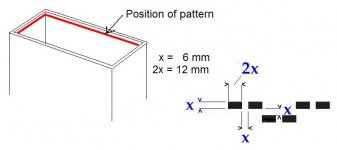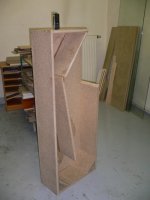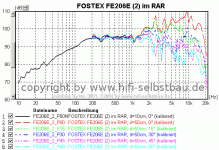peterbrorsson said:Hi Scott!
Thanks for reply!
No progress regarding pennant, I have been travelling quite a lot lately. Will see if I can buy some felt tomorrow.
Regarding bass, Sonido's has gotten little bit fuller "down under"
but still leaner than Monacors. It could be an optimistic fs on Sonido's or they still need more massage. Guess it can be the low qts also, bit of rising response for sure. It's not as it's fatiguing exactly, but noticable. Over all, much better sound.
Regarding sales points, I guess it's easiest to contact Sonido directly or, ask Spectrum Audio in Germany.
You can call the owner of Sonido, Istvan Vargas, he speak's English.
+36 309 640 683
BTW, I made an experiment with turning them around. Tested with different heights, restricting the mouth etc.....
Even my wife said to give it up, the nearest description is un-musical bass. Hard and short bass, tones were not decaying normally + it got the floor vibrating. Noticable loss of low bass also. Makes me wonder about reflctions back up the pipe.
Regards,
Peter
Have to edit the contact name at Sonido. His name is Zoltan Varga!
peterbrorsson said:Scott, I tested bass tracks this evening also, I got quite strong output at 30Hz while 40Hz was so overwhelming, that the cat and children ran out of the room
The problem here is that the Sonido's excite room nodes much more than Monacors. If I play 30Hz and move alittle to the right and left, it feels like eardrums are sucked in. The cancellation in certain places are huge. Also there is a dip around 60-80 Hz but this dip is even in the whole room. It makes me wonder if they should be a tad shorter, lets say around 1.4m. This is possible to do without any problems, technical speaking from wood working point of wiew.
G'day peterbrorsson,
Try the following and see if this addresses you room node issues.
Parts list:
- Scotch Magic Tape (19mm)
- Duct tape (PVC)
- Cutting knife or blade
- Cutting Mat
- Ruler
Instructions
1. Lay strips of Scotch Magic tape sticky side down on a cutting mat
2. Lay a strip of duct tape sticky side down also on the cutting mat
3. Using a blade, cut the duct tape into 12mm x 6mm rectangles (blocks)
4. Pick the blocks off the cutting mat using the blade
5. Lay the blocks on top of the Magic tape EXACTLY as per the pattern pictured below
6. Peel up the Magic tape with attached blocks
7. Stick into the BIB mouth on all four sides (see pic)
I think you will be pleasantly surprised.
Cheers,
Alex
Attachments
Well, for me highs are enough, but its subjective thing. I did not measure anything. Right now they are playing firing up from the cartoon opened box, because without horn loading and during burn in it seamed to me a lot of upper midrange and highs.
I`m thinking also about come TQWP design, but with closed botttom and Karlson slot on the side for 2/3 of the pipe. Slot can be made with just multiple wholes located in K-slot princip. Just to get more load for driver with low Qts. Bur its just an idea, probably will try but after making AION.
I`m thinking also about come TQWP design, but with closed botttom and Karlson slot on the side for 2/3 of the pipe. Slot can be made with just multiple wholes located in K-slot princip. Just to get more load for driver with low Qts. Bur its just an idea, probably will try but after making AION.
G'day Alex!
I have followed the enabl thread and I've hesitated treating the drivers. This what you describe is reversible and not complicated.
Though I doubt it will solve the excess of mids from the mouth.
I'll have a shot at it anyway.
There are for sure issues with panel vibrations at the mouth.
I would say side + back panel should be doubled or at least braced the last half of the pipe.
Regarding the inner baffle, I can't feel any vibrations. Maybe not necessary here.
Peter
I have followed the enabl thread and I've hesitated treating the drivers. This what you describe is reversible and not complicated.
Though I doubt it will solve the excess of mids from the mouth.
I'll have a shot at it anyway.
There are for sure issues with panel vibrations at the mouth.
I would say side + back panel should be doubled or at least braced the last half of the pipe.
Regarding the inner baffle, I can't feel any vibrations. Maybe not necessary here.
Peter
G'day again Alex!
Funny thing about room nodes. I got my Naim equipment (amp+cd) back from service this week. I haven't used it for quite a long time. Call me nuts if you like, but room nodes and some of mids coming out is better. Room nodes are for sure much better while mid leakage are still there, but little less. Still not good though. Also a tendency of phase issue when moving my head sideways has dissapeared. Weird huh!
I have tried the pennant, with maybe to thin material, without result. I will get some more dense felt later in week.
Peter
Funny thing about room nodes. I got my Naim equipment (amp+cd) back from service this week. I haven't used it for quite a long time. Call me nuts if you like, but room nodes and some of mids coming out is better. Room nodes are for sure much better while mid leakage are still there, but little less. Still not good though. Also a tendency of phase issue when moving my head sideways has dissapeared. Weird huh!
I have tried the pennant, with maybe to thin material, without result. I will get some more dense felt later in week.
Peter
Time for some update here!
Tried the pennant with variuos thickness, to be honest, couldn't hear any difference than without. For now I've given up on bib's.
I have thrown together Sonido's horn in one weekend and have been listening to them for a while.
Same low bass capacity ~35Hz, BUT the 80-200 Hz are a huge improvement. Much more whack in drums for sure, they are also more even in the output from mouth than mine bib's.
However there are problems in first track of Pink Floyds "The Division Bell". It's ear bleeding to listen at the piano. This track is what I normally use for evaluating speakers. If it's problem with the piano here, I usually get tired of the speakers sooner or later.
Shall fiddle with the damping a little bit more + reinforce the mouth a bit, then we'll see what to do next.....OB?
Peter
Tried the pennant with variuos thickness, to be honest, couldn't hear any difference than without. For now I've given up on bib's.
I have thrown together Sonido's horn in one weekend and have been listening to them for a while.
Same low bass capacity ~35Hz, BUT the 80-200 Hz are a huge improvement. Much more whack in drums for sure, they are also more even in the output from mouth than mine bib's.
However there are problems in first track of Pink Floyds "The Division Bell". It's ear bleeding to listen at the piano. This track is what I normally use for evaluating speakers. If it's problem with the piano here, I usually get tired of the speakers sooner or later.
Shall fiddle with the damping a little bit more + reinforce the mouth a bit, then we'll see what to do next.....OB?
Peter
Attachments
soft fibre
Hello,
take soft fibre the press chamber and the first meter
of the horn, this will reduce enclosure sounds and hard
reflexions of frequencies over ~250 Hz,
you can reduce the first "Schallschnelle" over 100 Hz and
over 320 Hz the first and the second.
I optimized this old trick over the last ~28 years, look
my horns.
And most of all 8" need help below 800 Hz this does´t work with a bass horn, a horn is only good for 3 oktaven.
Don´t trust catalog measurements, compair it with real
measurements.
Hello,
take soft fibre the press chamber and the first meter
of the horn, this will reduce enclosure sounds and hard
reflexions of frequencies over ~250 Hz,
you can reduce the first "Schallschnelle" over 100 Hz and
over 320 Hz the first and the second.
I optimized this old trick over the last ~28 years, look
my horns.
And most of all 8" need help below 800 Hz this does´t work with a bass horn, a horn is only good for 3 oktaven.
Don´t trust catalog measurements, compair it with real
measurements.
Re: soft fibre
I trust my ears only
hm said:
Don´t trust catalog measurements, compair it with real
measurements.
I trust my ears only

The 178 is actually a 6 1/2in driver Horst. It's the SFR200 that's the 8in. Agreed wholeheartedly about not trusting published specs, -look at how far off Lowther's are. BTW '...And most of all 8" need help below 800 Hz. Does that mean you're suggesting that all 8in drivers have a mass corner of 800Hz?

Hello,
look the published frequence diagrams of these drivers:
Visaton B200
Seas Exotic F8
Fostex FE 206 E
Audio Nirvana 8"
Sica LP 208.38 1100
Ciare HX 201
div. Lowther
Sonido 8"
Lyeco LY805F
Lowther by AER:
http://www.aer-original.com/html/hobby_hifi_01_jan_2002.html
than you will understand.
example 206 by Selbstbau.de:
look the published frequence diagrams of these drivers:
Visaton B200
Seas Exotic F8
Fostex FE 206 E
Audio Nirvana 8"
Sica LP 208.38 1100
Ciare HX 201
div. Lowther
Sonido 8"
Lyeco LY805F
Lowther by AER:
http://www.aer-original.com/html/hobby_hifi_01_jan_2002.html
than you will understand.
example 206 by Selbstbau.de:
Attachments
I'm afraid you'll think I'm dense (you won't be alone in that...  ), but I still can't see why everything below 800Hz requires boosting for every single driver.
), but I still can't see why everything below 800Hz requires boosting for every single driver.
Looking at the very interesting FR graph for the 206 you attach, we see at the bottom end of the scale, the driver's natural low frequency roll-off below its mass corner (the -3db point Fhm being determined by the equation 2Fs / Qt). And we also see the characteristic rising response of a low Q unit. This is a variable point -the AN drivers exhibit this rise at a relatively low frequency for example, while the response of the 206 does not start to rise until slightly over 1KHz. Are you using 800Hz as a mean value?
Anyway, regarding the rising response of a driver of this type, then AFAIK, there isn't a great deal a back-loaded cabinet with only a single driver mounted can do to correct for it without resorting to a shelving filter, though a lengthy horn of any kind should help attenuate the rise to varying extents due to its high damping causing HF roll-off.
As such, my own take on it (which is certainly not the only one; just my own view) is that you can really only concentrate on boosing the driver's SPLs with a back-loaded enclosure below its moving mass corner, or as far as that is possible / practical to achieve, & handle the driver's naturally rising response via other means, if it proves to be a problem. FWIW, the -3db moving mass corner fhm for 3 of the drivers you refer to above based on published specs (purely as an example) are:
Visaton B200: 105.96Hz
Fostex FE206E: 433.33Hz
AN Standard 8: 410.3Hz
Regards
Scott
 ), but I still can't see why everything below 800Hz requires boosting for every single driver.
), but I still can't see why everything below 800Hz requires boosting for every single driver. Looking at the very interesting FR graph for the 206 you attach, we see at the bottom end of the scale, the driver's natural low frequency roll-off below its mass corner (the -3db point Fhm being determined by the equation 2Fs / Qt). And we also see the characteristic rising response of a low Q unit. This is a variable point -the AN drivers exhibit this rise at a relatively low frequency for example, while the response of the 206 does not start to rise until slightly over 1KHz. Are you using 800Hz as a mean value?
Anyway, regarding the rising response of a driver of this type, then AFAIK, there isn't a great deal a back-loaded cabinet with only a single driver mounted can do to correct for it without resorting to a shelving filter, though a lengthy horn of any kind should help attenuate the rise to varying extents due to its high damping causing HF roll-off.
As such, my own take on it (which is certainly not the only one; just my own view) is that you can really only concentrate on boosing the driver's SPLs with a back-loaded enclosure below its moving mass corner, or as far as that is possible / practical to achieve, & handle the driver's naturally rising response via other means, if it proves to be a problem. FWIW, the -3db moving mass corner fhm for 3 of the drivers you refer to above based on published specs (purely as an example) are:
Visaton B200: 105.96Hz
Fostex FE206E: 433.33Hz
AN Standard 8: 410.3Hz
Regards
Scott
- Status
- This old topic is closed. If you want to reopen this topic, contact a moderator using the "Report Post" button.
- Home
- Loudspeakers
- Full Range
- Sonido BIB



